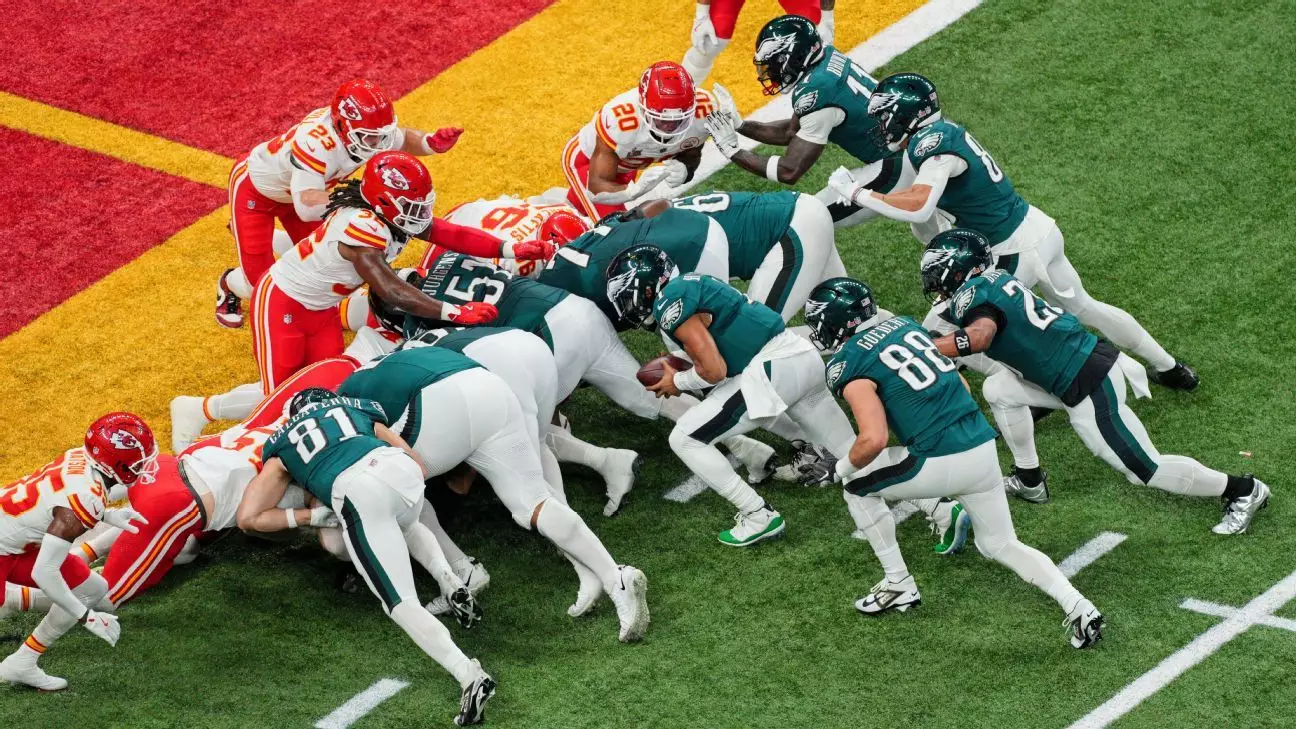The proposal to ban the “tush push” quarterback sneak has ignited a contentious debate within the National Football League (NFL). As reported by Troy Vincent, the NFL’s executive vice president of football operations, this rule change discussion is gaining traction among league officials and could potentially reshape game strategies. With the proposal set to be pitched for a vote in an upcoming owners’ meeting, the implications of its acceptance or rejection could resonate through the league for seasons to come.
At its core, the “tush push” involves a quarterback attempting a sneak with the support of one or more players pushing him from behind. This play has become emblematic of the Philadelphia Eagles’ playing style, particularly under coach Nick Sirianni and quarterback Jalen Hurts. Over the last three NFL seasons, the Eagles, along with the Buffalo Bills, executed this maneuver 163 times—an impressive feat that far outstrips attempts by the rest of the league. What distinguishes the Eagles’ execution of this play is their staggering success rate: 87% of attempts resulted in either a touchdown or a first down, significantly more than the league average of 71%.
It is crucial to analyze why the “tush push” has become a focal point for NFL rule proposals. Proponents of the play argue that it is a strategic choice that showcases teamwork and physicality, stressing that it is merely an evolution of the quarterback sneak. Critics, however, voice concerns that this tactic might distort the essence of fair competition and increase the risk of injury, as it often involves intense physical confrontations at the line of scrimmage.
The concerns surrounding the “tush push” are not limited to mere strategy; they tap into deeper issues regarding competitive integrity within the league. By allowing one team to dominate a particular play, the NFL risks creating a less balanced competitive environment. With the Eagles and Bills reaping most of the benefits, other teams find themselves struggling to adapt or counter such a unique strategy. This creates a ripple effect, forcing teams either to mimic the play or develop elaborate defenses against it. The debate thus extends beyond the play itself, raising questions about how the league structures competitiveness and whether special rules should be enforced to ensure all teams can compete equally.
Coaches like Sirianni have publicly defended the play, arguing that its success is a testament to preparation and execution rather than an unfair advantage. Nevertheless, Vincent’s acknowledgment that this play is on the league’s agenda indicates that the conversation about modifying or banning it has merit in the eyes of some franchises and league officials. It demonstrates the difficulty in balancing innovation with tradition in a constantly evolving game.
As the NFL continues to grow and attract new audiences, the league’s rules must evolve to reflect changing dynamics on the field. Vincent’s statement that “there are some concerns, some challenges” highlights the league’s willingness to critically assess strategies that feature high success rates but pose questions about player safety and fairness. The push for rules surrounding quarterback sneaks also mirrors broader trends in professional sports, where discussions regarding player welfare and competitive balance frequently take center stage.
What remains to be seen is how NFL owners will respond to the proposal. A vote of 24 out of 32 owners is required for any rule to pass, which could lead to significant lobbying from coaches and team executives who are invested in maintaining or banning the “tush push.” This decision could either reinforce or redefine traditional football tactics, signaling a shift towards a more regulated playing environment.
The debate surrounding the “tush push” is emblematic of larger themes within the NFL, where tradition and innovation often clash. As the owners’ meeting approaches, the outcome of this proposal could set a precedent for how the league navigates the fine line between encouraging competitive strategies and ensuring safety and fairness on the field. The stakes are high, and the implications of this decision will be felt throughout the league for seasons to come.


Leave a Reply